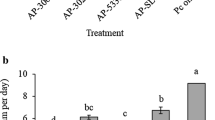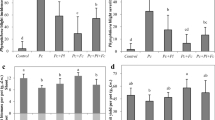Abstract
Cape gooseberry cultivated in commercial greenhouses developed wilt and root rot during the summer growing season of 2013 in Aichi Prefecture, Japan. A Pythium species was isolated from affected roots and identified as P. aphanidermatum on the basis of morphological characteristics and sequence homologies in the rDNA internal transcribed spacer regions. In pathogenicity tests, this isolate caused severe wilt and root rot. P. aphanidermatum, which previously was not known to cause damping-off in Cape gooseberry, was isolated by a bait method from soil samples collected from within and outside of the greenhouses. Pre- and post-inoculation activity of phosphonate and two fungicides, cyazofamid and metalaxyl, was evaluated with in vivo experiments. The three compounds were applied 3 days before inoculation, and phosphonate and cyazofamid also were applied at 24 h after inoculation. All three substances provided similar protectant activity. Phosphonate and cyazofamid also exhibited curative activity. In vitro activity of phosphonate on mycelial growth, sporulation, and zoospore cyst germination was evaluated; the EC50 concentration for the inhibition of mycelial growth was low. Zoospore formation was sensitive to phosphonate, while the germination of encysted zoospores was not.



Similar content being viewed by others
References
Afek U, Sztejnberg A (1989) Effects of fosetyl-Al and phosphorous acid on scoparone, a phytoalexin associated with resistance of citrus to Phytophthora citrophthora. Phytopathology 79:736–739
Al-Sa’di AM, Drenth A, Deadman ML, Al-Said FA, Khan I, Aitken EAB (2008) Potential sources of Pythium inoculum into greenhouse soils with no previous history of cultivation. J Phytopathol 156:502–505
Altschul SF, Madden TL, Schäffer AA, Zhang J, Zhang Z, Miller W, Lipman DJ (1997) Gapped BLAST and PSI-BLAST: a new generation of protein database search programs. Nucleic Acids Res 25:3389–3402
Anderson MG, Fortnum BA, Martin SB (1997) First report of Pythium myriotylum in a tobacco seedling float system in South Carolina. Plant Dis 81:227
Chellemi DO, Mitchell DJ, Kannwischer-Mitchell ME, Rayside PA, Rosskopf EN (2000) Pythium spp. associated with bell pepper production in Florida. Plant Dis 84:1271–1274
Cook PJ, Landschoot PJ, Schlossberg MJ (2009) Inhibition of Pythium spp. and suppression of Pythium blight of turfgrasses with phosphonate fungicides. Plant Dis 93:809–814
Erwin DC, Ribeiro OK (1996) Phytophthora diseases worldwide. Chemical control. APS Press, St. Paul, pp 211–237
Fenn ME, Coffey MD (1984) Studies on the in vitro and in vivo antifungal activity of fosetyl-Al and phosphorous acid. Phytopathology 74:606–611
Fisher DJ, Hayes AL (1982) Mode of action of the systemic fungicides furalaxyl, metalaxyl and ofurace. Pestic Sci 13:330–339
Guest DI, Bompeix G (1990) The complex of action of phosphonates. Australas Plant Pathol 19:113–115
Hendrix FF Jr, Campbell WA (1973) Pythiums as plant pathogens. Annu Rev Phytopathol 11:77–98
Jackson TJ, Burgess T, Colquhoun I, Hardy GE StJ (2000) Action of the fungicide phosphite on Eucalyptus marginata inoculated with Phytophthora cinnamomi. Plant Pathol 49:147–154
Kageyama K, Aoyagi T, Sunouchi R, Fukui H (2002) Root rot of miniature roses caused by Pythium helicoides. J Gen Plant Pathol 68:15–20
Ko WH, Chase LL, Kunimoto RK (1973) A microsyringe method for determining concentration of fungal propagules. Phytopathology 63:1206–1207
Kromann P, Pérez WG, Taipe A, Schulte-Geldermann E, Sharma BP, Andrade-Piedra JL, Forbes GA (2012) Use of phosphonate to manage foliar potato late blight in developing countries. Plant Dis 96:1008–1015
Matheron ME, Porchas M (2000) Impact of azoxystrobin, dimethomorph, fluazinam, fosetyl-Al, and metalaxyl on growth, sporulation, and zoospore cyst germination of three Phytophthora spp. Plant Dis 84:454–458
Mitani S, Araki S, Takii Y, Ohshima T, Matsuo N, Miyoshi H (2001a) The biochemical mode of action of the novel selective fungicide cyazofamid: specific inhibition of mitochondrial complex III in Phythium spinosum. Pestic Biochem Physiol 71:107–115
Mitani S, Araki S, Yamaguchi T, Takii Y, Ohshima T, Matsuo N (2001b) Antifungal activity of the novel fungicide cyazofamid against Phytophthora infestans and other plant pathogenic fungi in vitro. Pestic Biochem Physiol 70:92–99
Miyake N, Nagai H, Kageyama K (2014) Wilt and root rot of poinsettia caused by three high-temperature-tolerant Pythium species in ebb-and-flow irrigation systems. J Gen Plant Pathol 80:479–489
Morita Y, Tojo M (2007) Modifications of PARP medium using fluazinam, miconazole, and nystatin for detection of Pythium spp. in soil. Plant Dis 91:1591–1599
Rebollar-Alviter A, Madden LV, Ellis MA (2007) Pre- and post-infection activity of azoxystrobin, pyraclostrobin, mefenoxam, and phosphite against leather rot of strawberry, caused by Phytophthora cactorum. Plant Dis 91:559–564
Smillie R, Grant BR, Guest D (1989) The mode of action of phosphite: evidence for both direct and indirect modes of action on three Phytophthora spp. in plants. Phytopathology 79:921–926
Tojo M, Fujita Y, Awad HM, Ichitani T (1993) Preparation of Pythium inocula using bentgrass seeds for glasshouse studies (in Japanese). Proc Kansai Pl Prot 35:1–5
van der Plaats-Niterink AJ (1981) Monograph of the genus Pythium. Stud Mycol 21:1–242
Watanabe H, Taguchi Y, Hyakumachi M, Kageyama K (2007) Pythium and Phytophthora species associated with root and stem rots of kalanchoe. J Gen Plant Pathol 73:81–88
Watanabe H, Kageyama K, Taguchi Y, Horinouchi H, Hyakumachi M (2008) Bait method to detect Pythium species that grow at high temperatures in hydroponic solutions. J Gen Plant Pathol 74:417–424
Waterhouse GM (1967) Key to Pythium pringsheim. Mycol Pap 109:1–15
White TJ, Bruns T, Lee S, Taylor JW (1990) Amplification and direct sequencing of fungal ribosomal RNA genes for phylogenetics. In: Innis MA, Gelfand DH, Sninsky JJ, White TJ (eds) PCR protocols: a guide to methods and applications. Academic Press, San Diego, pp 315–322
Acknowledgments
This work was supported by Science and Technology Research Promotion Program for Agriculture, Forestry, Fisheries and Food Industries from the Ministry of Agriculture, Forestry and Fisheries, Japan.
Author information
Authors and Affiliations
Corresponding author
Additional information
The nucleotide sequences reported here are available in the DNA Data Bank of Japan (DDBJ), European Molecular Biology Laboratory (EMBLE), and GenBank databases under Accession Number AB915193.
Rights and permissions
About this article
Cite this article
Miyake, N., Nagai, H., Kato, S. et al. Detection of damping-off of Cape gooseberry caused by Pythium aphanidermatum and its suppression with phosphonate. J Gen Plant Pathol 81, 192–200 (2015). https://doi.org/10.1007/s10327-015-0582-2
Received:
Accepted:
Published:
Issue Date:
DOI: https://doi.org/10.1007/s10327-015-0582-2




